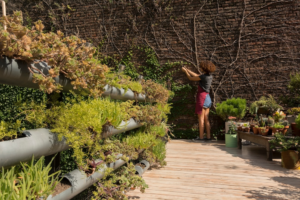Beauty with Purpose
When we think of landscaping, we often focus on aesthetics—lush greenery, vibrant flowers, and neatly arranged pathways. But what if your landscape could do more than just look good? What if it could withstand environmental challenges, promote sustainability, and even improve your well-being? By incorporating resilient landscaping into your decorative designs, you create a space that is both visually stunning and functionally beneficial.
What is Resilient Landscaping?
Resilient landscaping is an approach that adapts to environmental stressors like drought, extreme temperatures, and poor soil conditions. It focuses on sustainability, biodiversity, and self-sufficiency while still maintaining beauty.
Benefits of Resilient Decorative Landscaping
1. Eco-Friendly and Sustainable 
Reduces water consumption by incorporating drought-resistant plants
Improves soil health through mulching and composting
Supports local wildlife by planting native species
2. Improves Mental & Physical Health 
Being surrounded by greenery has been shown to reduce stress and anxiety
Exposure to nature can boost immunity and encourage outdoor activity
Edible landscaping (fruit trees, herbs, and medicinal plants) promotes a healthier lifestyle
3. Saves Time & Money 
Requires less maintenance than traditional high-water landscapes
Reduces dependency on chemical fertilizers and pesticides
Increases property value with a functional, well-planned outdoor space
How to Create a Resilient Decorative Landscape
1. Choose Native & Drought-Tolerant Plants
Opt for hardy perennials, succulents, and native wildflowers that thrive in your region’s climate. These plants require less water and maintenance while providing a lush, natural aesthetic.
2. Incorporate Edible Landscaping
Adding fruit-bearing plants, medicinal herbs, or nutrient-rich greens to your landscape makes it both beautiful and functional. Imagine a space filled with lavender for relaxation, rosemary for cooking, and elderberry for immunity support!
3. Improve Soil Health Naturally
Healthy soil is the foundation of a resilient landscape. Incorporate:
Mulch to retain moisture and prevent erosion
Compost for natural fertilization
Ground cover plants to reduce soil depletion
4. Use Hardscaping Wisely
Integrate natural stone pathways, gravel beds, and permeable pavers to reduce runoff and enhance drainage. These elements add structure to your landscape while helping manage water efficiently.
5. Create a Microclimate for Comfort
Strategic tree placement provides shade, reduces wind exposure, and naturally cools your home, lowering energy costs while making outdoor spaces more enjoyable.
6. Attract Pollinators & Beneficial Insects
Encourage biodiversity by planting nectar-rich flowers like coneflowers, lavender, and sunflowers. This attracts bees, butterflies, and birds that support plant growth and balance the ecosystem.
Final Thoughts
A resilient decorative landscape blends beauty, sustainability, and function to create an environment that benefits both you and the planet. By designing your outdoor space with native plants, edible gardens, and smart water conservation techniques, you’ll enjoy a landscape that thrives year-round with minimal upkeep—all while improving your well-being.
Start transforming your yard today and enjoy the lasting rewards of a resilient and health-conscious outdoor space!


5 Responses
test
test my blog
Test
I’m leaving my understanding here.
This is a test for blog page